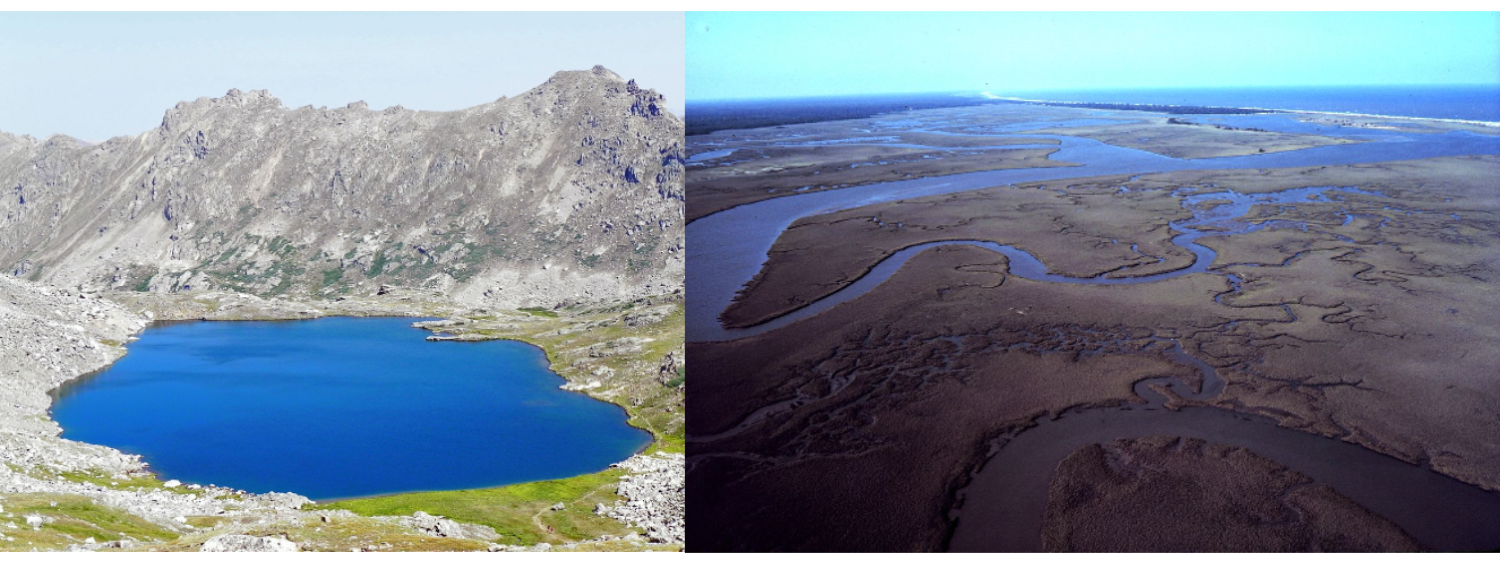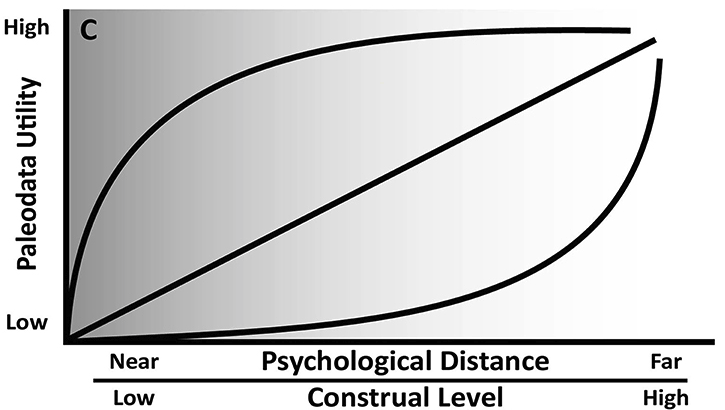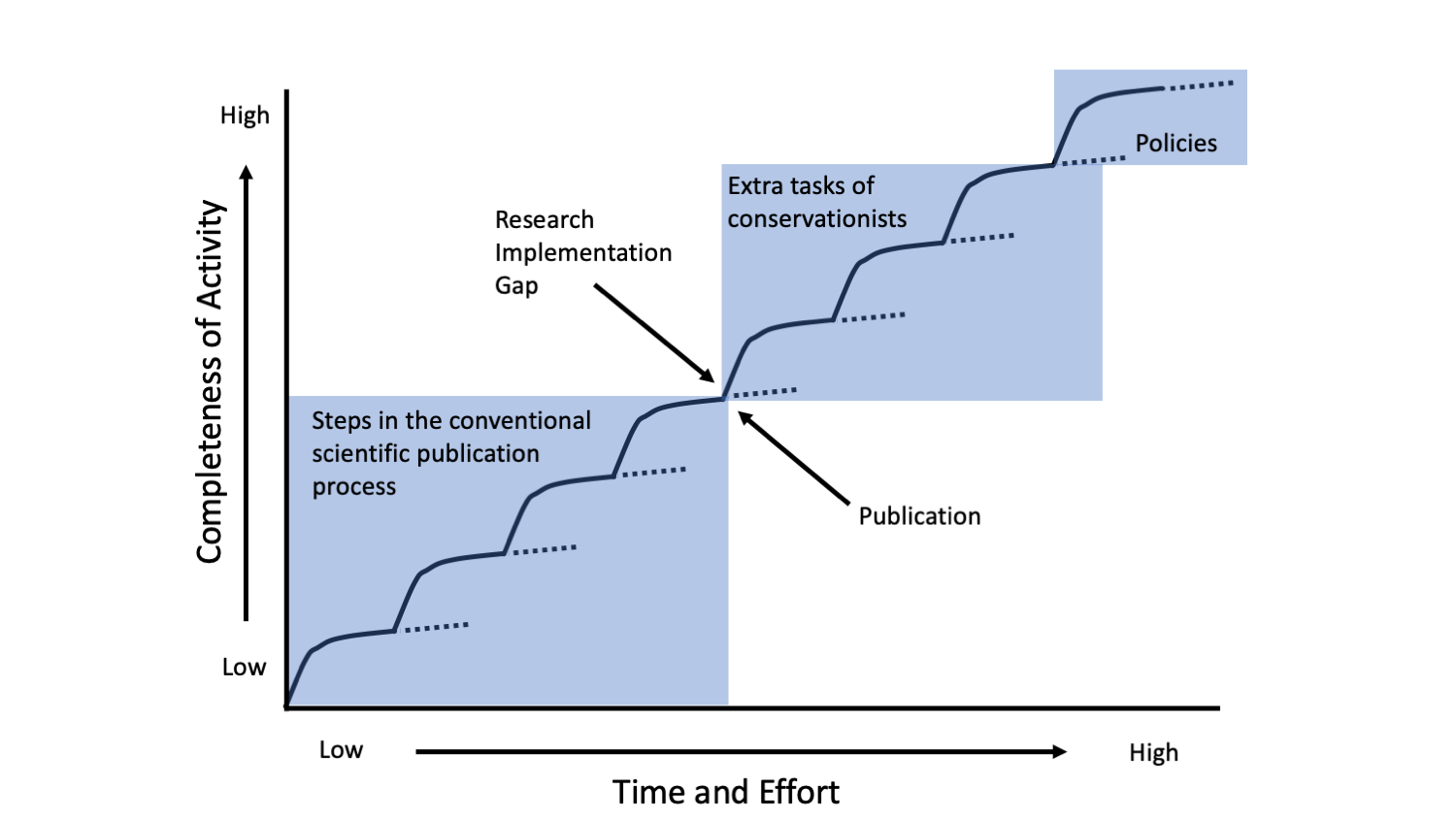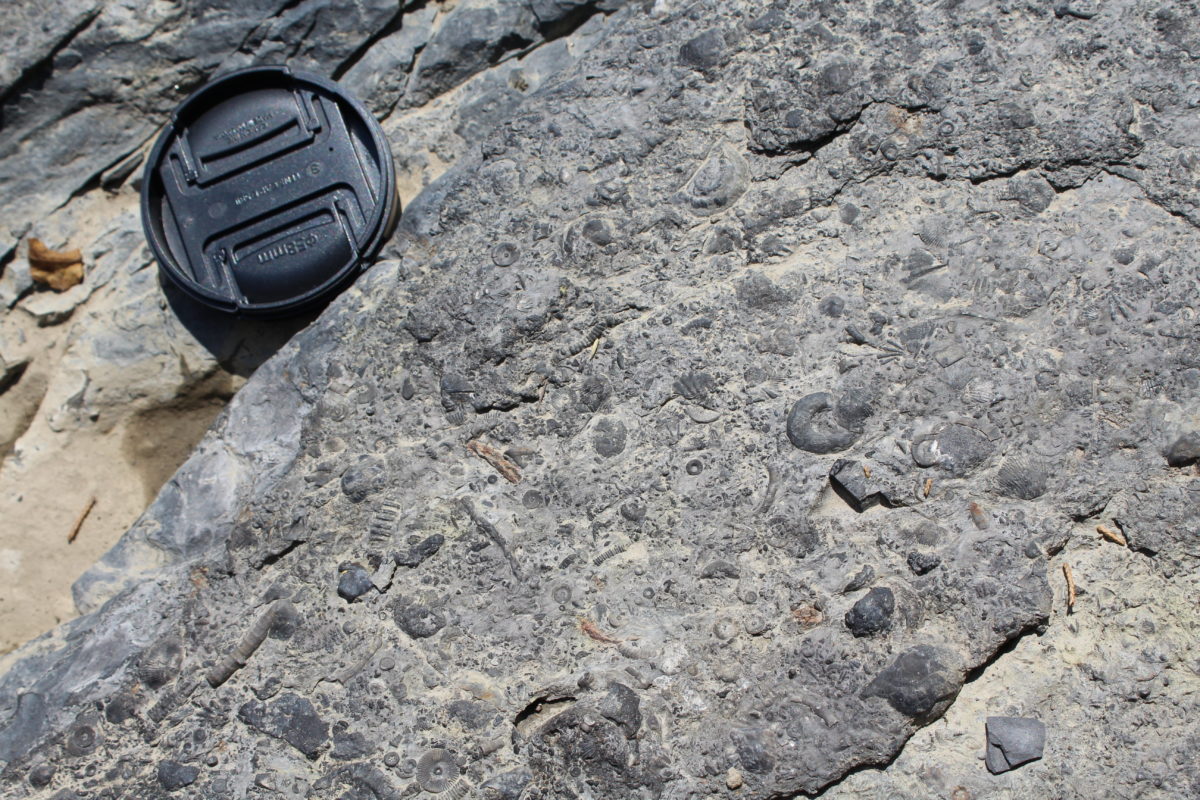Chapter contents:
Conservation Paleobiology
– 1. Foundations in Conservation Biology
– 2. Approaches in Conservation Paleobiology
–– 2.1 Near-time Approaches
–– 2.2 Deep-time Approaches
– 3. Deliverables from Conservation Paleobiology
– 4. Barriers to Applying Conservation Paleobiology ←
Above image by Jansen Smith.
Introduction
Conservation paleobiology has the potential to improve conservation and restoration practice through the unique long-term perspective it provides. Nonetheless, a variety of barriers inhibit this utilization of geohistorical records. These barriers include general awareness about the availability of geohistorical records; a lack of trust in, and familiarity with, geohistorical records; psychological preconditioning; and, as with most branches of conservation science, a gap between the theoretical research being conducted and the actual implementation of conservation and restoration practice.
Awareness
The vast majority of people conducting conservation and restoration work do not have backgrounds in the Earth sciences. For many people, their only Earth science experiences may have been a class in high school or in college. Likewise, paleobiological specimens, data, and concepts are not encountered by most people on a regular basis. Very often, when people think of “paleontology,” they think: old, dead, dinosaur, or maybe Ross (if they watched the TV show Friends). The idea of applying paleobiological data to conservation does not enter the realm of possibility for most people. Connected to all this, there is a general lack of awareness that paleobiological data can be applied to conservation. For conservation paleobiologists, one of the first steps to overcome this barrier is to educate others on the relevance of the past history of life to present-day concerns.
The general availability of geohistorical records is also underestimated in some cases. As discussed in introductory section on Conservation Paleobiology, it is important to match research questions and conservation queries to the availability and suitability of geohistorical records. This foundational principle does mean that there will not always be geohistorical records relevant to every conservation concern. However, in many cases, records are available, and this is especially true in lacustrine and near-shore marine ecosystems. In these ecosystems, sediments tend to accumulate and there is a high likelihood of preserving organismal remains. Although these high-resolution, locally relevant records are often available, they are very rarely used to inform conservation decisions. In fact, when sampling living communities in near-shore marine ecosystems, dead shells are almost always found in the samples that are collected and are almost always discarded without any further consideration. By working more closely with practitioners and biologists, conservation paleobiologists can open discussions on the relevance of these records and improve the awareness of their utility.

A lake (left) and estuary (right), two environments that tend to accumulate sediments and preserve geohistorical records. Left image by Fredlyfish4; Creative Commons Attribution-Share Alike 3.0 Unported license. Right image from NOAA Photo Library; Creative Commons Attribution 2.0 Generic license.
Trust
The data typically used in conservation practice and the data from geohistorical records in conservation paleobiology have several inherent differences. These differences, if for no other reason than a lack of familiarity, can induce uncertainty and a lack of trust in their applicability. As discussed in the section on geohistorical records, the data from conservation paleobiology are often time-averaged and prone to preservational bias due to taphonomic processes. Comparatively, the data used in conservation tend to be from direct observations of ecosystems or experiments. Whereas paleobiologists work with time-averaged and taphonomically altered assemblages (see also the discussion on paleocommunities in the Paleoecology chapter), the idea that these assemblages are incomplete and/or an average of the community over decades or centuries can be unsettling. As with the awareness barrier, one of the best ways to build trust in the applicability of geohistorical records is through discussion of the different assumptions and different mindset they require.
Psychology
Underlying the awareness and trust barriers is a psychological preference for the familiar. As described by the construal level theory of psychological distance, people tend to think of objects and events that are psychologically distant in more abstract terms. Psychologically close objects and events, in contrast, conjure concrete thinking and connections. Different perceptions of psychological distance—relating to time, space, social dynamics, and hypotheticality—can also influence each other. When something is considered “far” in one dimension, it is usually considered “far” in all dimensions. This is true of geohistorical records, and conservation paleobiology in general. Geohistorical records are, by nature, psychologically distant in the time dimension; they are often from hundreds, thousands, or even millions of years ago. By being “far” temporally, geohistorical records will be thought of as “far” in the other dimensions. Because of this distancing, the perception is that geohistorical records are less relevant to the here-and-now. With this in mind, it is not surprising that most conservation practitioners do not think about geohistorical records on a regular basis and are not familiar with them; they are thought about only abstractly and as less relevant because of their temporal distance.

"Hypothetical relationships between perceived paleodata utility and construal level/psychological distance. Multiple lines indicate our uncertainty in the relationship." Figure and caption from Dietl et al. (2019) in Frontiers in Ecology and Evolution (Creative Commons Attribution 4.0 International license).
When it comes to climate change, however, there has been some recognition that geohistorical records are more useful. Thought about in terms of psychological distance, this makes sense. For many people, climate change is thought of as a long-term process and a far-off problem, impacting the future or places far away. As geohistorical records are thought of at a similarly far psychological distance, the connection with climate change may be due to this shared distance: climate change is a long-term process, so long-term data are needed to address it. This statement is not wrong, but it also does not tell the whole story. Namely, just because geohistorical records are thought of distantly and abstractly does not mean that they are not relevant. Even so, the psychological perception of these records likely needs to be adjusted before they will be put into widespread use. Climate change will be a good place to start because there is already common ground; it has been recognized as a stressor that geohistorical records can address.
The research-implementation gap
The research-implementation gap is a commonly encountered barrier in the conservation sciences, and conservation paleobiology is no different. The so called “gap” describes the disconnect between researchers and practitioners. Researchers in academic settings design experiments, collect data, and test theories; they then publish those studies in academic journals. Practitioners are often more concerned with the immediate changes and stressors in the area they are managing. Most of the time, researchers do not work with practitioners in designing experiments and practitioners do not have access to the work of researchers because it exists behind paywalls. Additionally, work that might be theoretically interesting to a researcher is not necessarily relevant to practitioners. As a consequence of these dynamics, thousands of published papers on conservation biology have little or no bearing on actual conservation practice. Paradoxically, much of the research on conservation biology does not actually have a direct impact on conservation actions.

The process from conception of an idea to the implemenation of new policy. Typically, academic researchers only complete the steps in the lower left box, which ends in the publication of research in a peer-reviewed journal. When this is the end point, a gap exists between knowledge generation and conservation action. In order to implement conservation and restoration practices, additional steps are required (middle box). Likewise, turning best practices into policy requires additional time and effort. Figure redrawn from Arlettaz et al. (2010) in Bioscience.
Fortunately, this gap is beginning to close. There is undoubtedly value in purely academic research, and it will continue to be produced in conservation biology. Still, many conservation biologists are now working more closely with on-the-ground practitioners to develop research questions that can provide data and insights on issues of immediate concern. By working more closely, researchers and practitioners both benefit, and so too do the theoretical and applied sides of conservation biology.
Concept check: See what you know!
Name three barriers to the utilization of geohistorical data in conservation and restoration practice.
Barriers include: awareness, trust, psychology, and the research-implementation gap.
Which of the following is not an ecosystem likely to have good geohistorical records: Lakes, Forests, or Estuaries?
Forests are the least likely of these three ecosystems to contain good geohistorical records. In lakes and estuaries, sediments and records commonly accumulate.
True or False: Geohistorical records are often perceived as psychologically close and concrete.
False. Geohistorical records are most often thought about abstractly, and as psychologically far.
Of the five environmental stressors (climate change, habitat change, overexploitation, invasive species, and pollution), which represents the best opportunity to begin integrating geohistorical records into conservation practice?
Climate change likely represents the best opportunity because it is commonly thought of at a similar psychological distance as geohistorical records.
In your own words, what is the research-implementation gap?
The research-implementation gap is the disconnect between researchers and practitioners and represents a break in the flow of information between these groups.
References and Further Reading
Arlettaz, R., M. Schaub, J. Fournier, T. S. Reichlin, A. Sierro, J. E. Watson, and V. Braunisch. 2010. From publications to public actions: when conservation biologists bridge the gap between research and implementation. BioScience, 60: 835-842.
Barnosky, A. D., E. A. Hadly, P. Gonzalez, J. Head, P. D. Polly, A. M. Lawing, et al. 2017. Merging paleobiology with conservation biology to guide the future of terrestrial ecosystems. Science, 355: eaah4787.
Birks, H. J. B. 2012. Ecological palaeoecology and conservation biology: controversies, challenges, and compromises. International Journal of Biodiversity Science, Ecosystem Services & Management, 8: 292-304.
Dietl, G. P., S. M. Kidwell, M. Brenner, D. A. Burney, K. W. Flessa, S. T. Jackson, and P. L. Koch. 2015. Conservation paleobiology: leveraging knowledge of the past to inform conservation and restoration. Annual Review of Earth and Planetary Sciences, 43: 79-103.
Dietl, G., J. A. Smith, and S. Durham. 2019. Discounting the past: the undervaluing of paleontological data in conservation science. Frontiers in Ecology and Evolution, 7: 108.
Kidwell, S. M. 2015. Biology in the Anthropocene: Challenges and insights from young fossil records. Proceedings of the National Academy of Sciences, 112: 4922-4929.
Knight, A. T., R. M. Cowling, M. Rouget, A. Balmford, A. T. Lombard, and B. M. Campbell. 2008. Knowing but not doing: selecting priority conservation areas and the research–implementation gap. Conservation biology, 22: 610-617.
Rick, T. C., and R. Lockwood. 2013. Integrating paleobiology, archeology, and history to inform biological conservation. Conservation Biology, 27: 45-54.
Smith, J. A., S. R. Durham, and G. P. Dietl. 2018. Conceptions of long-term data among marine conservation biologists and what conservation paleobiologists need to know. Pp. 23 - 54, in: Marine Conservation Paleobiology, (C. L. Tyler & C. L. Schneider (eds.), Springer, Cham.
Usage
Unless otherwise indicated, the written and visual content on this page is licensed under a Creative Commons Attribution-NonCommercial-ShareAlike 4.0 International License. This page was written by Jansen A. Smith. See captions of individual images for attributions. See original source material for licenses associated with video and/or 3D model content.




